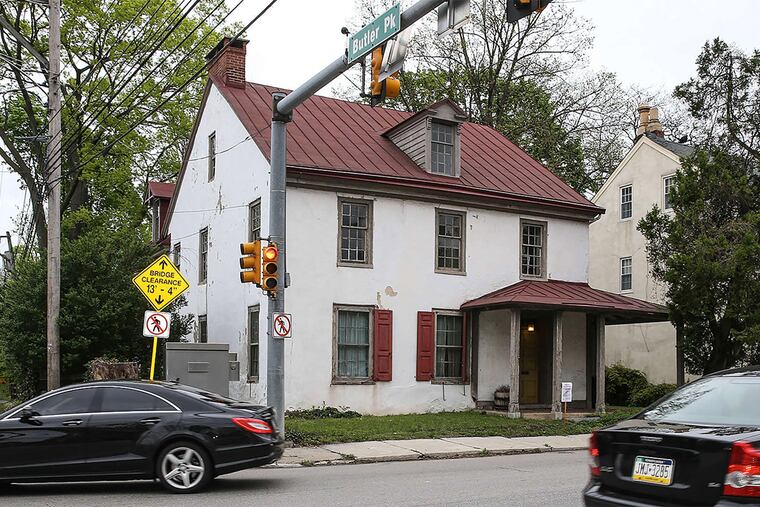Coexistence sought for Underground Railroad site and townhouses
When the enemies of slavery were turned away from community meeting places, farmer and lime merchant George Corson gave them a sanctuary where they could rail loud and long against what was known as "the peculiar institution."

When the enemies of slavery were turned away from community meeting places, farmer and lime merchant George Corson gave them a sanctuary where they could rail loud and long against what was known as "the peculiar institution."
Cobbled together in 1856 from a carriage shed and a stone barn at Germantown and Butler Pikes, Abolition Hall became a locus for the antislavery movement in a neighborhood that already was an Underground Railroad station as significant as any in the United States.
Many of its buildings, humble monuments to a turning point in the nation's history, still stand in what are today Whitemarsh and Plymouth Townships in Montgomery County, and a group of residents has mobilized to protect them.
Abolition Hall, Corson's home next door, and a Civil War-era general store occupy a 101/2-acre tract that they soon could be sharing with a development of 48 townhouses.
The parcel, which includes about eight acres of open space, is the subject of a sales agreement negotiated between three descendants of George and Martha Corson and K. Hovnanian Homes of Red Bank, N.J.
The sketch plans for the proposed development preserve the buildings, which are listed on the National Register of Historic Places and are part of a federally designated historic district. However, residents worry about the loss of open space - farmed until recently - and the possibility that the structures would be squeezed onto such a small piece of land that they could not be repurposed.
"This is a place where people risked their lives," said one of the protesting residents, Dave Miller of Conshohocken. He attends the historic Plymouth Monthly Meeting of Friends across the street from the site. "You can stand on the spot and tell the story."
Whitemarsh Township has concerns, as well. The township's Board of Supervisors has authorized its legal counsel to oppose a zoning application that the developer has filed with the township.
"This proposed development is located in our historic district and Whitemarsh Township wants to maintain the historic integrity of this district going forward," according to a statement by officials.
The township earlier sought to purchase the parcel - reportedly for $1.3 million - and preserve it as open space. The offer was declined, the statement said.
A hearing on the zoning application has been postponed at the developer's request, the township statement said. Anthony Maras, regional president at Hovnanian, did not return calls seeking comment.
Residents also are worried that the sketch plan appears to call for the straightening of Butler Pike, which crosses Germantown Pike in an awkward dogleg. Any relocation of the intersection would invariably affect the buildings, said Sydelle Zove of Miquon, a leader of the community effort.
The structures have been an integral part of area history since 1794, when lime burner Samuel Maulsby purchased a two-story stone house on 126 acres.
Maulsby and his wife, Susan Thomas Maulsby, both Quakers, sheltered slaves in their home, a mission they passed on to daughter Martha and her husband, George Corson.
When the Corsons moved into the Maulsby family home, they continued to hide slaves and transport them beneath hay in horse-drawn wagons. They hosted antislavery figures including Frederick Douglass.
In 1856, the Corsons added onto a carriage shed at the rear of a stone barn to create Abolition Hall, where the likes of William Lloyd Garrison, Harriet Beecher Stowe, and Lucretia Mott held forth.
"There were perhaps few more devoted men than George Corson to the interests of the oppressed everywhere," African American abolitionist William Still wrote in his 1872 book, The Underground Railroad.
Along with other safe houses in the neighborhood, the Corson property comprised one of the most important stations along the freedom highway, said historian Charles L. Blockson, founder of the Charles L. Blockson Afro-American Collection at Temple University.
In no other community along the railroad are as many buildings still standing that once hid slaves, Blockson said.
After the war, the Corson's daughter, Helen, an artist, married genre painter Thomas Hovenden, who turned Abolitionist Hall into his studio.
Hovenden, who replaced his friend Thomas Eakins as professor of painting at the Pennsylvania Academy of the Fine Arts, depicted subjects related to the fight against slavery. His masterwork, The Last Moments of John Brown, hangs at the Metropolitan Museum of Art in New York.
The family's role was recognized in 2000 when a state historic marker was placed along Butler Pike. Nancy Corson, George and Martha's great-granddaughter and a peace activist who died in 2012, had worked with Blockson to secure the marker.
Today, her niece Ann Wilson and Wilson's husband, Roy, both artists, live on the property. Wilson, along with two siblings, have signed an agreement to sell the parcel.
Wilson declined to discuss the possible sale.
The resident group is not necessarily opposed to development, said Zove. "But do it in a way that is respectful of the buildings' history, natural environment, and creates an opportunity for thoughtful adaptive reuse," she said.
Reducing the density of the proposed development and adding a solid buffer between it and the historic buildings would help, Zove said.
"Let's put good minds and hearts together," she said, "and come up with a plan for this village."
610-313-8211